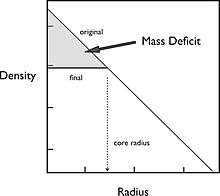Mass deficit
A mass deficit is the amount of mass (in stars) that has been removed from the center of a galaxy, presumably by the action of a binary supermassive black hole.

The density of stars increases toward the center in most galaxies. In small galaxies, this increase continues into the very center. In large galaxies, there is usually a "core", a region near the center where the density is constant or slowly rising. The size of the core – the "core radius" – can be as great as a few hundred parsecs in the largest elliptical galaxies.[1]
It is believed that cores are produced by binary supermassive black holes (SMBHs). Binary SMBHs form during the merger of two galaxies.[2] If a star passes near the massive binary, it will be ejected, by a process called the gravitational slingshot. This ejection continues until most of the stars near the center of the galaxy have been removed. The result is a low-density core. Such cores are ubiquitous in giant elliptical galaxies.[3]
The mass deficit is defined[4] as the amount of mass that was removed in creating the core. The figure illustrates how mass deficits are measured, using the observed brightness profile of a galaxy.[5] Mathematically, the mass deficit is defined as
where ρi is the original density, ρ is the observed density, and Rc is the core radius.
Observed mass deficits are typically in the range of one to a few times the mass of the central SMBH,[6] and observed core radii are comparable to the influence radii of the central SMBH. These properties are consistent with what is predicted in theoretical models of core formation [7] and lend support to the hypothesis that all bright galaxies once contained binary SMBHs at their centers.
It is not known whether most galaxies still contain massive binaries, or whether the two black holes have coalesced. Both possibilities are consistent with the presence of mass deficits.
References
- ↑ Ferrarese, Laura; et al. (2007). "The Inner Workings of Early-Type Galaxies: Cores, Nuclei and Supermassive Black Holes". In Karas, Vladimir; Matt, Giorgio. Black Holes: from Stars to Galaxies. Cambridge University Press. pp. 261–268. ISBN 978-0-521-86347-6.
- ↑ Begelman, M. C.; et al. (1980), "Massive black hole binaries in active galactic nuclei", Nature, 287: 307–309, Bibcode:1980Natur.287..307B, doi:10.1038/287307a0
- ↑ Graham, Alister (2012). "A review of elliptical and disc galaxy structure, and modern scaling laws". In McLean, I. S.; et al. Planets, Stars and Stellar Systems. Springer. ISBN 978-90-481-8817-8.
- ↑ Milosavljevic, Milos; Merritt, David; Rest, Armin; van den Bosch, Frank (2002), "Galaxy cores as relics of black hole mergers", Monthly Notices of the Royal Astronomical Society, 331 (4): L51–L55, arXiv:astro-ph/0110185
 , Bibcode:2002MNRAS.331L..51M, doi:10.1046/j.1365-8711.2002.05436.x
, Bibcode:2002MNRAS.331L..51M, doi:10.1046/j.1365-8711.2002.05436.x - ↑ Graham, Alister (2004), "Core Depletion from Coalescing Supermassive Black Holes", The Astrophysical Journal Letters, 613 (1): L33–L36, arXiv:astro-ph/0503177
 , Bibcode:2004ApJ...613L..33G, doi:10.1086/424928
, Bibcode:2004ApJ...613L..33G, doi:10.1086/424928 - ↑ Merritt, David (2013). Dynamics and Evolution of Galactic Nuclei. Princeton, NJ: Princeton University Press. ISBN 9781400846122.
- ↑ Merritt, David (2006), "Mass Deficits, Stalling Radii, and the Merger Histories of Elliptical Galaxies", The Astrophysical Journal, 648: 976–986, arXiv:astro-ph/0603439
 , Bibcode:2006ApJ...648..976M, doi:10.1086/506139
, Bibcode:2006ApJ...648..976M, doi:10.1086/506139
External links
- Ferrarese, L. and Merritt, D. (2002). Supermassive Black Holes. Physics World, June 2002, p. 41.